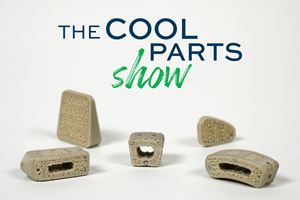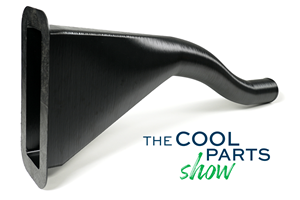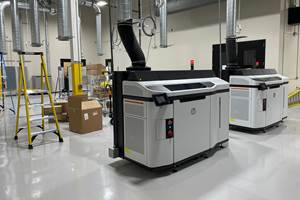APSX and Nexa3D Integrate Technologies to Advance Freeform Injection Molding
With the combined APSX-PIM and Nexa3D technologies, users can seamlessly transition from 3D printing prototypes to injection-molded production parts, all within a single, integrated ecosystem.
The Freeform Injection Molding (FIM) package includes everything users need to start printing tools and then produce parts right on the desktop, in which a rapidly evolving product development process, simplicity, speed and cost-effectiveness are paramount. Source: APSX
In a recent collaboration, APSX and Nexa3D say their united technologies can pioneer a new era in manufacturing. Their partnership engineers a seamless integration of the APSX-PIM desktop injection molding machine with Nexa3D’s 3D printers, culminating in a solution for freeform injection molding (FIM).
The companies say this synergy between precision injection molding and rapid 3D printing opens doors to unprecedented possibilities in product design, prototyping and production. It is said the FIM represents a paradigm shift in product development, enabling the creation of complex geometries and intricate designs that were previously unattainable through traditional manufacturing methods.
The APSX-PIM, known for its compact footprint and user-friendly interface, empowers businesses of all sizes to engage in injection molding with ease. Now, with the integration of Nexa3D’s advanced 3D printing capabilities, the APSX-PIM can transcend conventional boundaries, offering a comprehensive desktop FIM package that can transform manufacturing workflows.
By harnessing the precision and speed of Nexa3D’s printers, coupled with the versatility of the APSX-PIM, manufacturers can accelerate their innovation cycles and bring concepts to reality within a day. With the APSX-PIM and Nexa3D collaboration, users can seamlessly transition from 3D printing prototypes to injection molded production parts, all within a single, integrated ecosystem. This streamlined approach eliminates the need for costly and time-consuming tooling processes, thereby reducing lead times and maximizing productivity.
The benefits of FIM extend beyond prototyping, offering tangible advantages in various industries, including automotive, aerospace, consumer goods and more. Whether it’s rapid iteration during the design phase or on-demand production of end-use parts, the APSX-PIM and Nexa3D partnership empowers businesses to stay ahead in today's competitive market landscape. The basic steps for fully utilizing the integrated technologies follows.
Step-by-Step Guide: Making Parts with Nexa3D XiP and APSX-PIM
- Design: Begin the process by creating a 3D model of the desired part using CAD software. Leverage the freedom of design afforded by FIM to explore intricate geometries and complex structures.
- 3D Printing With Nexa3D XiP: Once the design is finalized, users transfer the model to the Nexa3D XiP printer, which will swiftly transforms digital designs into high-resolution 3D printed prototypes with speed and accuracy.
- Validation and Iteration: Evaluate the printed prototype to ensure it meets design specifications. With the rapid turnaround time of Nexa3D’s printers, users can iterate quickly to refine the design and address any potential issues.
- Mold Creation: Once the prototype is approved, users can proceed to create the mold using the Nexa3D mold generator software or another CAD software. Then 3D print the mold by using the xMOLD material on the Nexa3D XiP printer.
- Injection Molding: With the mold in place, users initiate the injection molding process using the APSX-PIM. The machine’s precise control and repeatability ensure consistent results, delivering high-quality parts with each cycle.
- Final Inspection: Conduct a thorough inspection of the molded parts to verify dimensional accuracy and test part functionality. Fine-tune the design until it hits your targets. With FIM, users can achieve tight tolerances and superior surface finishes to meet the most demanding specifications.
- Production Scaling: With the optimized workflow enabled by the APSX-PIM and Nexa3D collaboration, users can seamlessly scale production to meet demand while maintaining the highest standards of quality and efficiency.
To showcase the transformative potential of FIM, APSX has released a helpful blog post on its website as well as a video on its YouTube channel which delves into the capabilities and applications of this technology.
Related Content
FDA-Approved Spine Implant Made with PEEK: The Cool Parts Show #63
Curiteva now manufactures these cervical spine implants using an unusual 3D printing method: fused strand deposition. Learn how the process works and why it’s a good pairing with PEEK in this episode of The Cool Parts Show.
Read MoreAircraft Ducts 3D Printed in Composite Instead of Metal: The Cool Parts Show #68
Eaton’s new reinforced PEKK, tailored to aircraft applications, provides a cheaper and faster way to make ducts compared to formed aluminum.
Read MoreWhat Does Additive Manufacturing Readiness Look Like?
The promise of distributed manufacturing is alluring, but to get there AM first needs to master scale production. GKN Additive’s Michigan facility illustrates what the journey might look like.
Read MoreQ&A With Align EVP: Why the Invisalign Manufacturer Acquired Cubicure, and the Future of Personalized Orthodontics
Align Technology produces nearly 1 million unique aligner parts per day. Its acquisition of technology supplier Cubicure in January supports demand for 3D printed tooling and direct printed orthodontic devices at mass scale.
Read MoreRead Next
Postprocessing Steps and Costs for Metal 3D Printing
When your metal part is done 3D printing, you just pull it out of the machine and start using it, right? Not exactly.
Read MoreCrushable Lattices: The Lightweight Structures That Will Protect an Interplanetary Payload
NASA uses laser powder bed fusion plus chemical etching to create the lattice forms engineered to keep Mars rocks safe during a crash landing on Earth.
Read MoreProfilometry-Based Indentation Plastometry (PIP) as an Alternative to Standard Tensile Testing
UK-based Plastometrex offers a benchtop testing device utilizing PIP to quickly and easily analyze the yield strength, tensile strength and uniform elongation of samples and even printed parts. The solution is particularly useful for additive manufacturing.
Read More





















